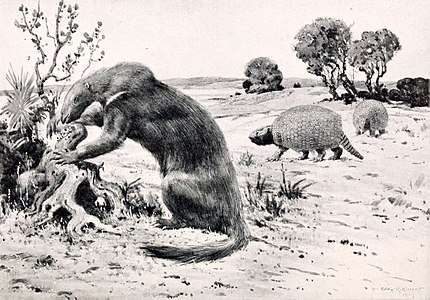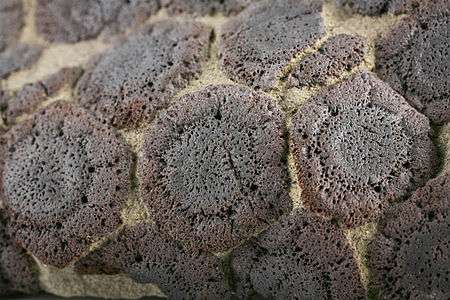Propalaehoplophorus
| Propalaehoplophorus | |
|---|---|
| Propalaeohoplophorus minor | |
| Scientific classification | |
| Kingdom: | Animalia |
| Phylum: | Chordata |
| Class: | Mammalia |
| Superorder: | Xenarthra |
| Order: | Cingulata |
| Family: | Chlamyphoridae |
| Subfamily: | †Glyptodontinae |
| Genus: | †Propalaehoplophorus Ameghino 1887 |
| Species | |
| |
| Synonyms | |
| |
Propalaehoplophorus, also written as Propalaeohoplophorus, is an extinct genus of glyptodont, which lived in South America during the Early Miocene epoch.[1]
Distribution
Fossils of Propalaehoplophorus have been found in the Santa Cruz Formation of Argentina, the Honda Group and Nazareno Formation of Bolivia and the Río Frías Formation of Chile.[2]
Gallery
 Restorations of Hapalops longiceps and Propalaeohoplophorus australis
Restorations of Hapalops longiceps and Propalaeohoplophorus australis Detail of a P. australis scute, early Miocene, in the permanent collection of The Children’s Museum of Indianapolis
Detail of a P. australis scute, early Miocene, in the permanent collection of The Children’s Museum of Indianapolis
References
| Wikimedia Commons has media related to Propalaeohoplophorus. |
- ↑ Vizcaíno, S. F.; Blanco, R. E.; Bender, J. B. N.; Milne, N. (2011). "Proportions and function of the limbs of glyptodonts". Lethaia. 44: 93. doi:10.1111/j.1502-3931.2010.00228.x.
- ↑ Propalaehoplophorus at Fossilworks.org
This article is issued from
Wikipedia.
The text is licensed under Creative Commons - Attribution - Sharealike.
Additional terms may apply for the media files.